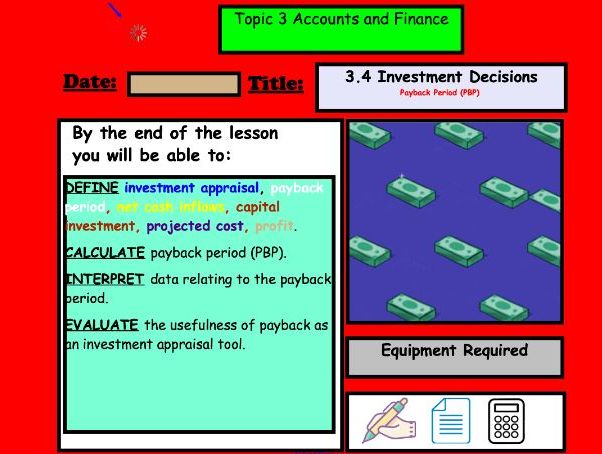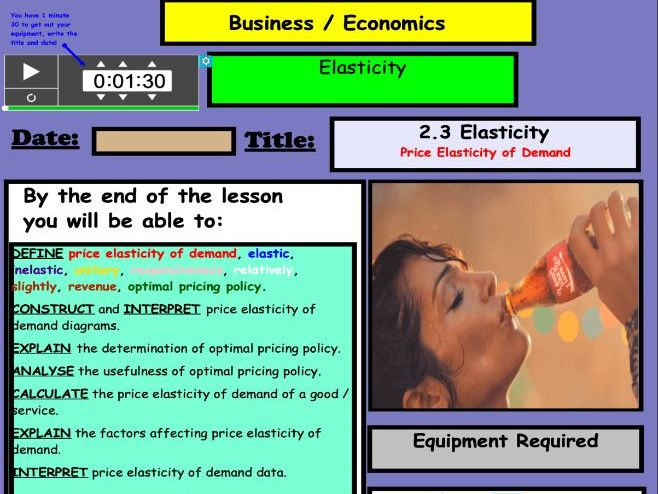66Uploads
6k+Views
5k+Downloads
All resources

Payback Period
Colourful slides, animations, video links, fun activities, as well as questions (with answers provided) are all included in this engaging and informative lesson on calculating the payback period, applicable to all syllabi
Included in the lesson is:
A fun (and very popular with my students!) Catchphrase starter activity where students have to guess the name of a well-known brand or product from a selection of pictures. Answers are provided.
An eye-catching slide used to explain the purpose of the lesson and introduce the terms capital investment appraisal.
An explanation of what it means to invest
Contextualised examples and explanations of what investing is with colourful slides and video links provided (a Bitcoin video is included as well as a link to live house price updates)
A ‘guess the price of the good’ activity that demonstrates reasons why people make investments (to get a return on their investment)
Examples of real business investments (Facebook purchasing WhatsApp, Oculus, extra warehouses for servers)
Explanation and step by step demonstration of how to calculate the payback period
A 10 - 15 minute activity where students need to calculate the payback period. Answers provided.
An explanation as how to evaluate the payback period
It took me a lesson and a half to go through all of the content

Production Possibility Frontier
A colourful, informative and engaging PowerPoint lesson on the production possibility frontier / curve (PPF/PPC).
Included in this lesson are:
A colourful and detailed title slide providing detailed learning objectives
A discussion starter activity that introduces the concept of choice
A mix and match activity where students need to identify and explain the difference between economic and free goods
Detailed notes
Consumer goods activity
Step by step break down of what the PPF is, opportunity cost, how it is calculated, marginal analysis, movements, shifts
There is also a free blank template of a PPF on my store that you can print and get students to fill in as it is explained

Types of Taxation (Direct and Indirect)
A colourful and detailed presentation that explores types of taxation. Included in this presentation:
A fun Catchphrase starter activity where students have to look at images to guess the name of a product or service (my students love this!)
An initial true or false quiz about types of taxes (England specific)
4 slides illustrating how much tax revenue the UK generates in comparison to other countries and how that tax revenue is spent. A sample payslip is also shown to illustrate some of the deducations are taken from income tax
Colourful and detailed examples of the main forms of tax students need to know about (income, corporation, VAT, National insurance, business rates)
A ‘how much income tax does Boris pay!’ activity that students love. It illustrates that income tax brackets are different at different thresholds of income
Disadvantages of taxation
Useful tips and notes as to how to evaluate a question that refers to taxation
This lesson took me an hour to complete

Price Elasticity of Demand WORKSHEET
A detailed and colourful worksheet designed to test a range of skills covered in this topic. The worksheet contains 6 activities, each taking between 5 and 15 minutes to complete. It took most of my students between 45 minutes and an hour to finish this worksheet. The activities are as follows:
Activity 1 - A fill the blanks activity that test students’ knowledge of the vocal and terminology used
Activity 2 - Calculating PED, percentage changes and recognising the different types of PED
Activity 3 - ‘Developing your answers’ - students need to recognise and explain factors that influence PED
Activity 4 - Revenue boxes
Activity 5 - Diagrams
Activity 6 - More complex calculations / application
ALL ANSWERS ARE PROVIDED IN DETAIL and have been written in a way that is broken down for students to easily understand. I ran this activity as a peer marking exercise and collected everyone’s work at the end of the lesson to check if there were any gaps in understand to review the following lesson. This saved a lot of time!

Depreciation (Business / Business Studies)
Description
A COLOURFUL, INFORMATIVE and ENGAGING presentation that on depreciation.
Included in this lesson:
A colourful and informative title slide that outlines the key skills covered in this topic, a list of equipment required, animated gif to grab the attention of students, and timing ‘prompt’ to get students to get the title down and equipment out as quickly as possible
A ‘guess the question’ starter activity where students are given the answers to ten questions relating to other Accounts / Finance related topics. Students need to work out what the ten questions were to get those answers. Answers are included in the presentation
An explanation of what the lesson aims are
An explanation of what assets are, contextualised to students
Informative, colourful and contextualised slides explaining what current and non-current assets, and depreciation are
A step by step guide to show how depreciation is calculated using the straight-line method, followed by an example for students to calculate (answers provided)
An explanation of the advantages and disadvantages of using the straight-line method to calculate depreciation
The same step by step guide, advantages and disadvantages for the reducing balance method
An exam style question where students need to calculate the value of depreciation, calculate how this affects the estimated value of an asset and when the right time to sell an asset it. Answers provided in the presentation with explanations
I’ve designed this lesson so that it can simply be opened and taught immediately. Each slide is self explanatory and easy to follow. There are 38 slides included in this lesson and it took me just under 2 hours to go through.

Price Elasticity of Demand
Colourful. Engaging. Informative. This PowerPoint has been creating to introduce students to the concept of price elasticity of demand.
Included in this PowerPoint:
A detailed and colourful title page, highlighting the skills that will be covered over the duration of this topic
A starter activity where students need to rank in order which goods / services would be most to least affected by a change in price
Discussion points
Slides detailing how price elasticity of demand is calculated, with an example
Slides explaining what the numerical values mean (how to interpret them)
Calculation questions with answers
Explanation of the factors affecting price elasticity of demand
This resource took me one hour to go through as a class






